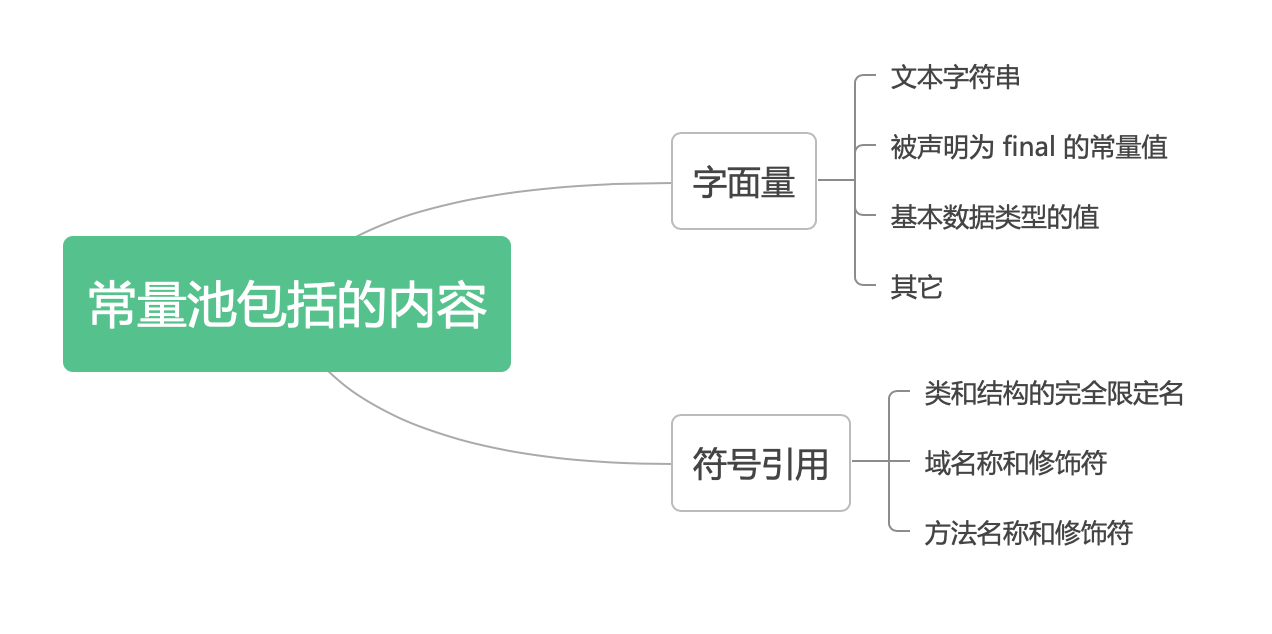本来想在 JVM 初探里面将 JVM 共享数据区里面的常量池讲清楚的,发现篇幅不够,因此另开了一个帖来唠唠。
常量池的实现是为了避免频繁的创建和销毁对象而影响系统的性能,实现了对象的共享。
平时会提及的 Java 中的常量池 Constant Pool 包括:
字符串常量池
在编译期间就把所有字符串文字放入一个常量池中:
- 对于
String s = "hello";直接生成放入常量池 - 对于
String s = new String("hello");常量池生成 “hello” 常量,new 的实例会在运行时在堆中创建
实现:StringTable 类,类似于一个 Hash 表
- Java 6 及之前版本:长度固定为 1009
- Java 7 及之后版本:长度可以通过参数设定
好处:
- 节省内存空间:在常量池中,所有相同的字符串常量会被合并,最终只占一个空间。
- 节省运行时间:比较字符串时
==比equals()快;对于两个引用变量,只用==判断引用是否相等,也就可以判断实际值是否相等。
小问题:两个线程共享字符串常量池同一个字符串,其中一个线程改变它会如何?
答:线程安全,因为 String 是 final 类
静态常量池
- 位于方法区中
- 在编译期为某个类生成某个 .class 文件的时候,会生成一个常量池
- 即:.class 文件中的常量池
- 用于存放编译期生成的:
- 各种字符串(数字)字面量(文本字符串、final 常量值等)
- 符号引用量(类和接口的全限定名,字段名称和描述符,方法名称和描述符)
- 类、方法的信息
- 以上占用了 .class 文件绝大部分空间。
- 池里面的数据项和数组项类似,使用索引访问。
运行时常量池
- 位于方法区中,存储元数据(类的版本、接口、域、方法等)
- 在类加载完成后,将 .class 文件中的常量池(静态常量池)加载到内存中,并保持到对应的区域
- 我们最常提及的常量池,就是这个运行时常量池,在程序运行的时候,常量也会产生,这些新的常量也会加入池中。
静态常量池和运行时常量池的区别主要如下图:

如果按照内容类别分,有以下两大类:

其他信息:
- Java 6 及之前,常量池位于方法区,从 Java 7 之后移到了堆中
- 类加载期间就把常量加载进了常量池
- 部分原子类型的包装类也有自己的常量池
Byte,Short,Integer,Long,Character,Boolean类型的常量池范围:除Boolean(true/false)、Character[0 - 127] 外全部为 [-128, 127]Float和Double类型没有常量池:与精度有关
- 原始数据类型的包装类和
String作为方法参数时,是值传递。
测试代码:1
2
3
4
5
6
7
8
9
10
11
12
13
14
15
16
17
18
19
20
21
22
23
24
25
26
27
28
29
30
31
32
33
34
35
36
37
38
39
40
41
42
43
44
45
46
47
48
49
50
51
52
53
54
55
56
57
58
59
60
61
62
63
64
65
66
67
68
69
70
71
72
73
74
75
76
77
78
79
80
81
82
83
84
85
86
87
88
89
90
91
92
93
94
95
96public class ConstantPoolTest {
private static final String hel = "hel";
private static final String lo = "lo";
public static void main(String[] args) {
Integer i1 = new Integer(1);
Integer i2 = new Integer(1);
// i1 != i2, 位于堆中非常量池的不同内存
int int3 = 1;
// i1 == int3, i2 == int3,比较时会自动拆箱
Integer i3 = -128;
Integer i4 = -128;
// i3 == i4, 指向常量池中同一内存(-128~127):since Java 5 的机制
// 自动装箱,Integer i3 = Integer.valueOf(-128);
// valueOf 会返回常量池中的对象或新生成堆中对象,此处返回常量池对象
// 注:算术计算(加减乘除)时也会自动拆箱
Integer i5 = 128;
Integer i6 = 128;
// i5 != i6, 指向不在常量池中
// 自动装箱,Integer i5 = Integer.valueOf(128);
// valueOf 会返回常量池中的对象或新生成堆中对象,此处返回堆中对象
Boolean b1 = true;
Boolean b2 = true;
// b1 == b2, 常量池
Double d1 = 1.0;
Double d2 = 1.0;
// d1 != d2, double/float 未实现常量池
String s1 = new String("hello");
String s2 = new String("hello");
// s1 != s2, 位于堆中非常量池的不同内存
String s3 = "hello";
String s4 = "hello";
// s3 == s4, 调用 String.valueOf(),指向常量池中同一内存
String hello = "hello", hel = "hel", lo = "lo";
/**
* hello == "hello", 指向常量池中同一内存
*
* hello == "hel" + "lo", 编译器自动对操作符右边的常量拼接进行优化:编译阶段就进行拼接
*
* hello != "hel" + lo, 编译器不会优化变量,过程相当于:
* - new StringBuilder().append("hel").append(lo).toString();
* - 通过 StringBuilder::toString 返回 new String(),所以是指向堆中的变量
*
* hello != hel + lo, 变量拼接不可预料,无法优化
* hello == Test.hel + Test.lo, 静态常量指向常量池中的常量
* hello == (hel + lo).intern(),手动载入常量池
* true,因执行 intern() 后返回的是 "hello" 在常量池中的对象
* Test.hel + Test.lo == (hel + lo).intern(),手动载入常量池
*/
hello.intern();
// 手动将字符串载入常量池,并将对应的符号常量作特殊处理
// Java 6 及之前:字符串如已存在于常量池,则直接返回该常量;否则将其加入到常量池
// Java 7 及以后:字符串如已存在于常量池,则直接返回该常量;否则说明字符串在堆中,将对在堆中的该字符串的引用(引用指向堆中的字符串)添加至常量池
// - 以后拿到的是该字符串的引用,实际则存在于堆中
String str1 = new String("1");
// 执行前:在常量池创建 "1"
// 执行时:new 一个 "1" 的对象存放到堆,然后 str1 指向堆中的变量
str1.intern(); // 查看 "1" 是否在常量池中,存在则直接返回该常量
String str2 = "1"; // 此时 "1" 已存在于常量池,str2 指向常量池的对象
System.out.println(str1 == str2); // false,因指向不同的位置
String str3 = new String("2") + new String("2");
// 底层调用 StringBuilder::append 拼接 "2" 和 "2",再调用 toString() 去 new 一个 String 对象 "22"
// 因此 "22" 是在堆里创建的
str3.intern(); // 此时堆中有 "22",但常量池还没有 "22"
// Java 6-:在常量池创建 "22"
// Java 7+:将堆中对 "22" 的引用放入常量池
String str4 = "22";
// Java 6- 指向常量池中的 "22"
// Java 7+ 指向常量池中的引用,即 str3,最终指向堆中的变量
System.out.println(str3 == str4);
// Java 6- 为 false(同 str1 与 str2 的比较)
// Java 7+ 为 true
String str5 = new String("3");
String str6 = "3";
str5.intern(); // "3" 已经存在于常量池中
System.out.println(str5 == str6); // false
String str7 = new String("4") + new String("4"); // 该 "44" 在堆里创建
String str8 = "44"; // 该 "44" 在常量池中创建
str7.intern(); // "44" 已经存在于常量池中,此时无论是 Java 6- 还是 Java 7+ 都直接返回常量值 "44"
System.out.println(str7 == str8); // false
}
}